Plasmon Sensitized Heterojunction 2D Ultrathin Ag/AgI-δ-Bi2O3 for Enhanced Photocatalytic Nitrogen Fixation
Abstract
:1. Introduction
2. Experimental Section
2.1. Synthesis of Photocatalysts
2.2. Characterization
2.3. Photocatalytic Reaction
3. Results and Discussion
4. Conclusions
Author Contributions
Funding
Conflicts of Interest
References
- Kobayashi, Y.; Tang, Y.; Kageyama, T.; Yamashita, H.; Masuda, N.; Hosokawa, S.; Kageyama, H. Titanium-Based Hydrides as Heterogeneous Catalysts for Ammonia Synthesis. J. Am. Chem. Soc. 2017, 139, 18240–18246. [Google Scholar] [CrossRef] [PubMed]
- Azofra, L.M.; Morlanés, N.; Poater, A.; Samantaray, M.K.; Vidjayacoumar, B.; Albahily, K.; Cavallo, L.; Basset, J.-M. Single-Site Molybdenum on Solid Support Materials for Catalytic Hydrogenation of N2-into-NH3. Angew. Chem. Int. Ed. 2018, 57, 15812–15816. [Google Scholar] [CrossRef] [PubMed]
- Chen, X.; Li, N.; Kong, Z.; Ong, W.-J.; Zhao, X. Photocatalytic fixation of nitrogen to ammonia: State-of-the-art advancements and future prospects. Mater. Horiz. 2018, 5, 9–27. [Google Scholar] [CrossRef]
- Bai, Y.; Ye, L.; Chen, T.; Wang, L.; Shi, X.; Zhang, X.; Chen, D. Facet-Dependent Photocatalytic N2 Fixation of Bismuth-Rich Bi5O7I Nanosheets. ACS Appl. Mater. Interfaces 2016, 8, 27661–27668. [Google Scholar] [CrossRef]
- Wang, S.; Hai, X.; Ding, X.; Chang, K.; Xiang, Y.; Meng, X.; Yang, Z.; Chen, H.; Ye, J. Light-Switchable Oxygen Vacancies in Ultrafine Bi5O7Br Nanotubes for Boosting Solar-Driven Nitrogen Fixation in Pure Water. Adv. Mater. 2017, 29, 1701774. [Google Scholar] [CrossRef] [PubMed]
- Li, H.; Shang, J.; Ai, Z.; Zhang, L. Efficient Visible Light Nitrogen Fixation with BiOBr Nanosheets of Oxygen Vacancies on the Exposed {001} Facets. J. Am. Chem. Soc. 2015, 137, 6393–6399. [Google Scholar] [CrossRef]
- Li, H.; Shang, J.; Shi, J.; Zhao, K.; Zhang, L. Facet-dependent solar ammonia synthesis of BiOCl nanosheets via a proton-assisted electron transfer pathway. Nanoscale 2016, 8, 1986–1993. [Google Scholar] [CrossRef]
- Dong, G.; Ho, W.; Wang, C. Selective photocatalytic N2 fixation dependent on g-C3N4 induced by nitrogen vacancies. J. Mater. Chem. A 2015, 3, 23435–23441. [Google Scholar] [CrossRef]
- Ye, L.; Han, C.; Ma, Z.; Leng, Y.; Li, J.; Ji, X.; Bi, D.; Xie, H.; Huang, Z. Ni2P loading on Cd0.5Zn0.5S solid solution for exceptional photocatalytic nitrogen fixation under visible light. Chem. Eng. J. 2017, 307, 311–318. [Google Scholar] [CrossRef]
- Li, Y.; Chen, X.; Zhang, M.; Zhu, Y.; Ren, W.; Mei, Z.; Gu, M.; Pan, F. Oxygen vacancy-rich MoO3−x nanobelts for photocatalytic N2 reduction to NH3 in pure water. Catal. Sci. Technol. 2019, 9, 803–810. [Google Scholar] [CrossRef]
- Ling, C.; Niu, X.; Li, Q.; Du, A.; Wang, J. Metal-Free Single Atom Catalyst for N2 Fixation Driven by Visible Light. J. Am. Chem. Soc. 2018, 140, 14161–14168. [Google Scholar] [CrossRef]
- Zhao, W.; Xi, H.; Zhang, M.; Li, Y.; Chen, J.; Zhang, J.; Zhu, X. Enhanced quantum yield of nitrogen fixation for hydrogen storage with in situ-formed carbonaceous radicals. Chem. Commun. 2015, 51, 4785–4788. [Google Scholar] [CrossRef]
- Xiao, C.; Zhang, L.; Wang, K.; Wang, H.; Zhou, Y.; Wang, W. A new approach to enhance photocatalytic nitrogen fixation performance via phosphate-bridge: A case study of SiW12/K-C3N4. Appl. Catal. B Environ. 2018, 239, 260–267. [Google Scholar] [CrossRef]
- Shiraishi, Y.; Shiota, S.; Kofuji, Y.; Hashimoto, M.; Chishiro, K.; Hirakawa, H.; Tanaka, S.; Ichikawa, S.; Hirai, T. Nitrogen Fixation with Water on Carbon-Nitride-Based Metal-Free Photocatalysts with 0.1% Solar-to-Ammonia Energy Conversion Efficiency. ACS Appl. Energy Mater. 2018, 1, 4169–4177. [Google Scholar] [CrossRef]
- Lu, Y.; Zhao, Y.; Zhao, J.; Song, Y.; Huang, Z.; Gao, F.; Li, N.; Li, Y. Induced Aqueous Synthesis of Metastable β-Bi2O3 Microcrystals for Visible-Light Photocatalyst Study. Cryst. Growth Des. 2015, 15, 1031–1042. [Google Scholar] [CrossRef]
- Sun, W.; Zhang, H.; Lin, J. Surface Modification of Bi2O3 with Fe(III) Clusters toward Efficient Photocatalysis in a Broader Visible Light Region: Implications of the Interfacial Charge Transfer. J. Phys. Chem. C 2014, 118, 17626–17632. [Google Scholar] [CrossRef]
- Wu, Y.-C.; Huang, Y.-T.; Yang, H.-Y. Crystallization mechanism and photocatalytic performance of vanadium-modified bismuth oxide through precipitation processes at room temperature. CrystEngComm 2016, 18, 6881–6888. [Google Scholar] [CrossRef]
- Xu, J.; Liu, J. Facet-Selective Epitaxial Growth of δ-Bi2O3 on ZnO Nanowires. Chem. Mater. 2016, 28, 8141–8148. [Google Scholar] [CrossRef]
- Xue, X.; Chen, R.; Chen, H.; Hu, Y.; Ding, Q.; Liu, Z.; Ma, L.; Zhu, G.; Zhang, W.; Yu, Q.; et al. Oxygen Vacancy Engineering Promoted Photocatalytic Ammonia Synthesis on Ultrathin Two-Dimensional Bismuth Oxybromide Nanosheets. Nano Lett. 2018, 18, 7372–7377. [Google Scholar] [CrossRef]
- Xu, C.; Qiu, P.; Li, L.; Chen, H.; Jiang, F.; Wang, X. Bismuth Subcarbonate with Designer Defects for Broad-Spectrum Photocatalytic Nitrogen Fixation. ACS Appl. Mater. Interfaces 2018, 10, 25321–25328. [Google Scholar] [CrossRef]
- Zhu, S.; Lu, L.; Zhao, Z.; Wang, T.; Liu, X.; Zhang, H.; Dong, F.; Zhang, Y. Mesoporous Ni-Doped δ-Bi2O3 Microspheres for Enhanced Solar-Driven Photocatalysis: A Combined Experimental and Theoretical Investigation. J. Phys. Chem. C 2017, 121, 9394–9401. [Google Scholar] [CrossRef]
- Yi, S.; Yue, X.; Xu, D.; Liu, Z.; Zhao, F.; Wang, D.; Lin, Y. Study on photogenerated charge transfer properties and enhanced visible-light photocatalytic activity of p-type Bi2O3/n-type ZnO heterojunctions. New J. Chem. 2015, 39, 2917–2924. [Google Scholar] [CrossRef]
- Jiang, H.-Y.; Liu, G.; Wang, T.; Li, P.; Lin, J.; Ye, J. In situ construction of α-Bi2O3/g-C3N4/β-Bi2O3 composites and their highly efficient photocatalytic performances. RSC Adv. 2015, 5, 92963–92969. [Google Scholar] [CrossRef]
- Tao, S.; Yang, M.; Chen, H.; Zhao, S.; Chen, G. Continuous Synthesis of Ag/AgCl/ZnO Composites Using Flow Chemistry and Photocatalytic Application. Ind. Eng. Chem. Res. 2018, 57, 3263–3273. [Google Scholar] [CrossRef]
- Yang, S.-F.; Niu, C.-G.; Huang, D.-W.; Zhang, H.; Liang, C.; Zeng, G.-M. SrTiO3 nanocubes decorated with Ag/AgCl nanoparticles as photocatalysts with enhanced visible-light photocatalytic activity towards the degradation of dyes, phenol and bisphenol A. Environ. Sci. Nano 2017, 4, 585–595. [Google Scholar] [CrossRef]
- Sun, L.; Wu, W.; Tian, Q.; Lei, M.; Liu, J.; Xiao, X.; Zheng, X.; Ren, F.; Jiang, C. In situ Oxidation and Self-Assembly Synthesis of Dumbbell-like α-Fe2O3/Ag/AgX (X = Cl, Br, I) Heterostructures with Enhanced Photocatalytic Properties. ACS Sustain. Chem. Eng. 2016, 4, 1521–1530. [Google Scholar] [CrossRef]
- Linic, S.; Christopher, P.; Ingram, D.B. Plasmonic-metal nanostructures for efficient conversion of solar to chemical energy. Nat. Mater. 2011, 10, 911–921. [Google Scholar] [CrossRef]
- Salmistraro, M.; Schwartzberg, A.; Bao, W.; Depero, L.E.; Weber-Bargioni, A.; Cabrini, S.; Alessandri, I. Triggering and Monitoring Plasmon-Enhanced Reactions by Optical Nanoantennas Coupled to Photocatalytic Beads. Small 2013, 9, 3301–3307. [Google Scholar] [CrossRef]
- Wang, Y.; Huang, X.; Wang, K.; Zhang, L.; Wang, B.; Fang, Z.; Zhao, Y.; Gao, F.; Liu, P.; Feng, W. Ag-modified ultrathin Bi12O17Cl2 nanosheets: Photo-assisted Ag exfoliation synthesis and enhanced photocatalytic performance. J. Mater. Chem. A 2018, 6, 9200–9208. [Google Scholar] [CrossRef]
- Wang, Y.; Niu, C.-G.; Wang, L.; Wang, Y.; Zhang, X.-G.; Zeng, G.-M. Synthesis of fern-like Ag/AgCl/CaTiO3 plasmonic photocatalysts and their enhanced visible-light photocatalytic properties. RSC Adv. 2016, 6, 47873–47882. [Google Scholar] [CrossRef]
- Wang, H.; Yong, D.; Chen, S.; Jiang, S.; Zhang, X.; Shao, W.; Zhang, Q.; Yan, W.; Pan, B.; Xie, Y. Oxygen-Vacancy-Mediated Exciton Dissociation in BiOBr for Boosting Charge-Carrier-Involved Molecular Oxygen Activation. J. Am. Chem. Soc. 2018, 140, 1760–1766. [Google Scholar] [CrossRef] [PubMed]
- Ji, M.; Chen, R.; Di, J.; Liu, Y.; Li, K.; Chen, Z.; Xia, J.; Li, H. Oxygen vacancies modulated Bi-rich bismuth oxyiodide microspheres with tunable valence band position to boost the photocatalytic activity. J. Colloid Interface Sci. 2019, 533, 612–620. [Google Scholar] [CrossRef] [PubMed]
- Wang, R.; Wan, J.; Jia, J.; Xue, W.; Hu, X.; Liu, E.; Fan, J. Synthesis of In2Se3 homojunction photocatalyst with α and γ phases for efficient photocatalytic performance. Mater. Des. 2018, 151, 74–82. [Google Scholar] [CrossRef]
- Cai, T.; Liu, Y.; Wang, L.; Zhang, S.; Zeng, Y.; Yuan, J.; Ma, J.; Dong, W.; Liu, C.; Luo, S. Silver phosphate-based Z-Scheme photocatalytic system with superior sunlight photocatalytic activities and anti-photocorrosion performance. Appl. Catal. B Environ. 2017, 208, 1–13. [Google Scholar] [CrossRef]
- Alessandri, I.; Depero, L.E. Using plasmonic heating of gold nanoparticles to generate local SER(R)S-active TiO2 spots. Chem. Commun. 2009, 2359–2361. [Google Scholar] [CrossRef]
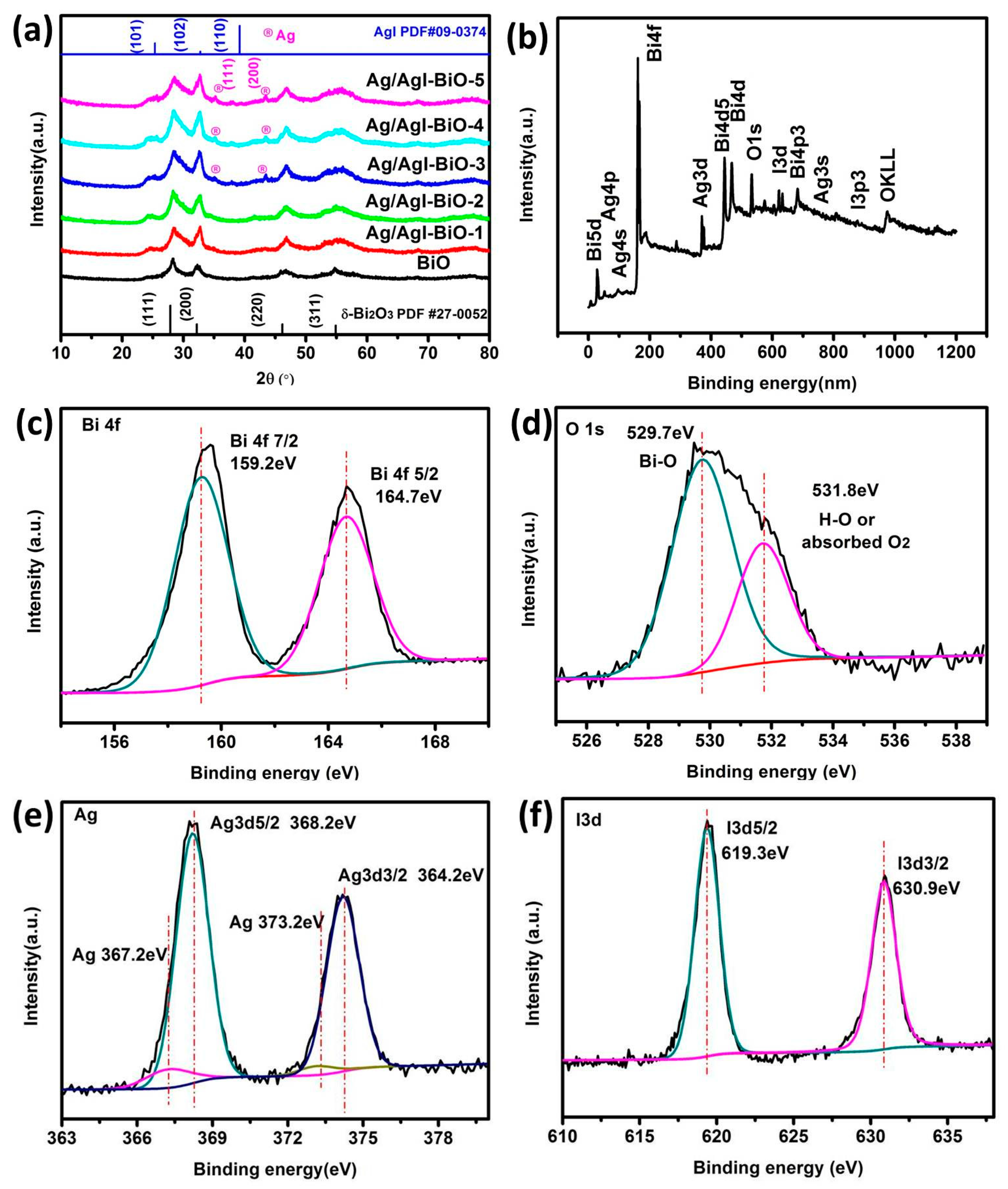
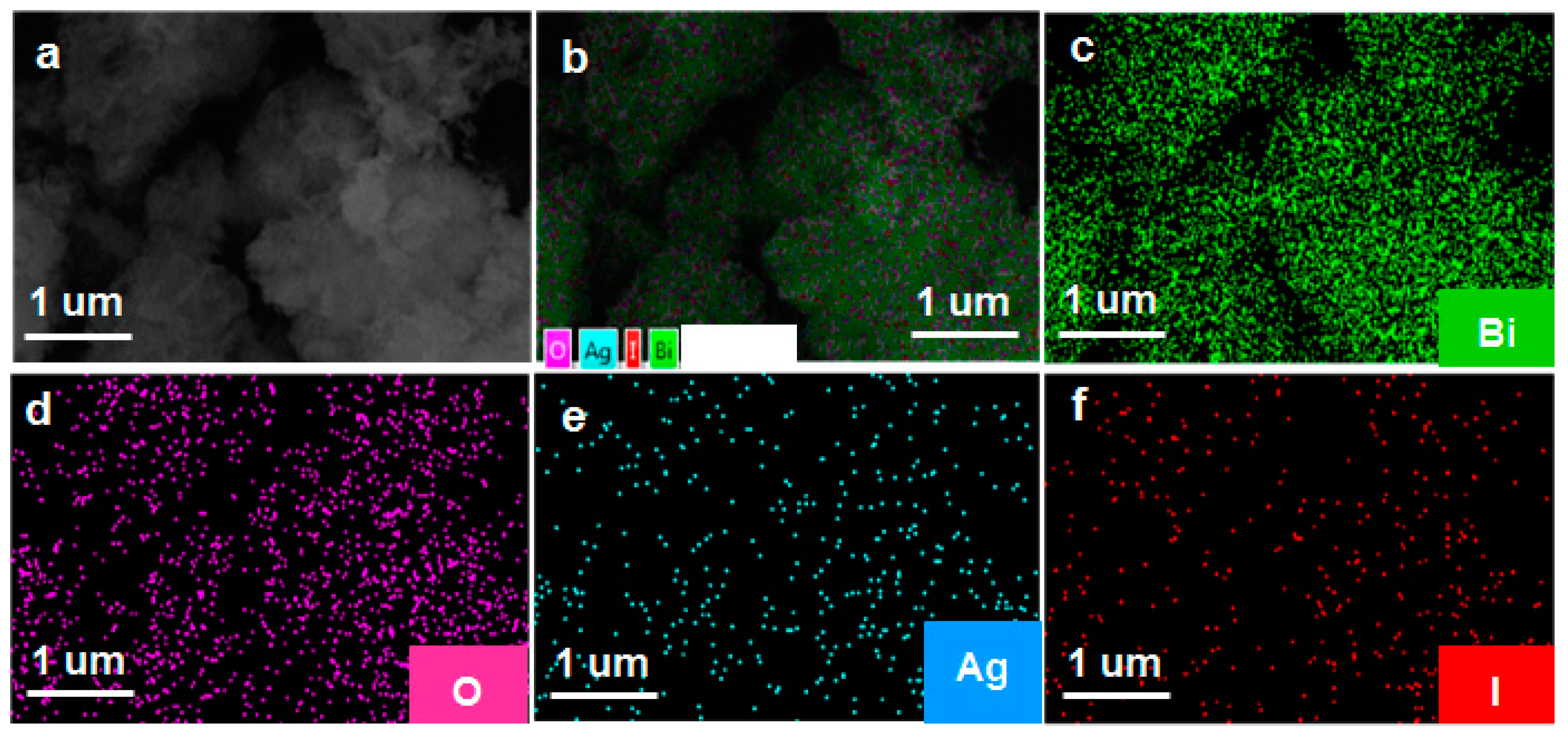
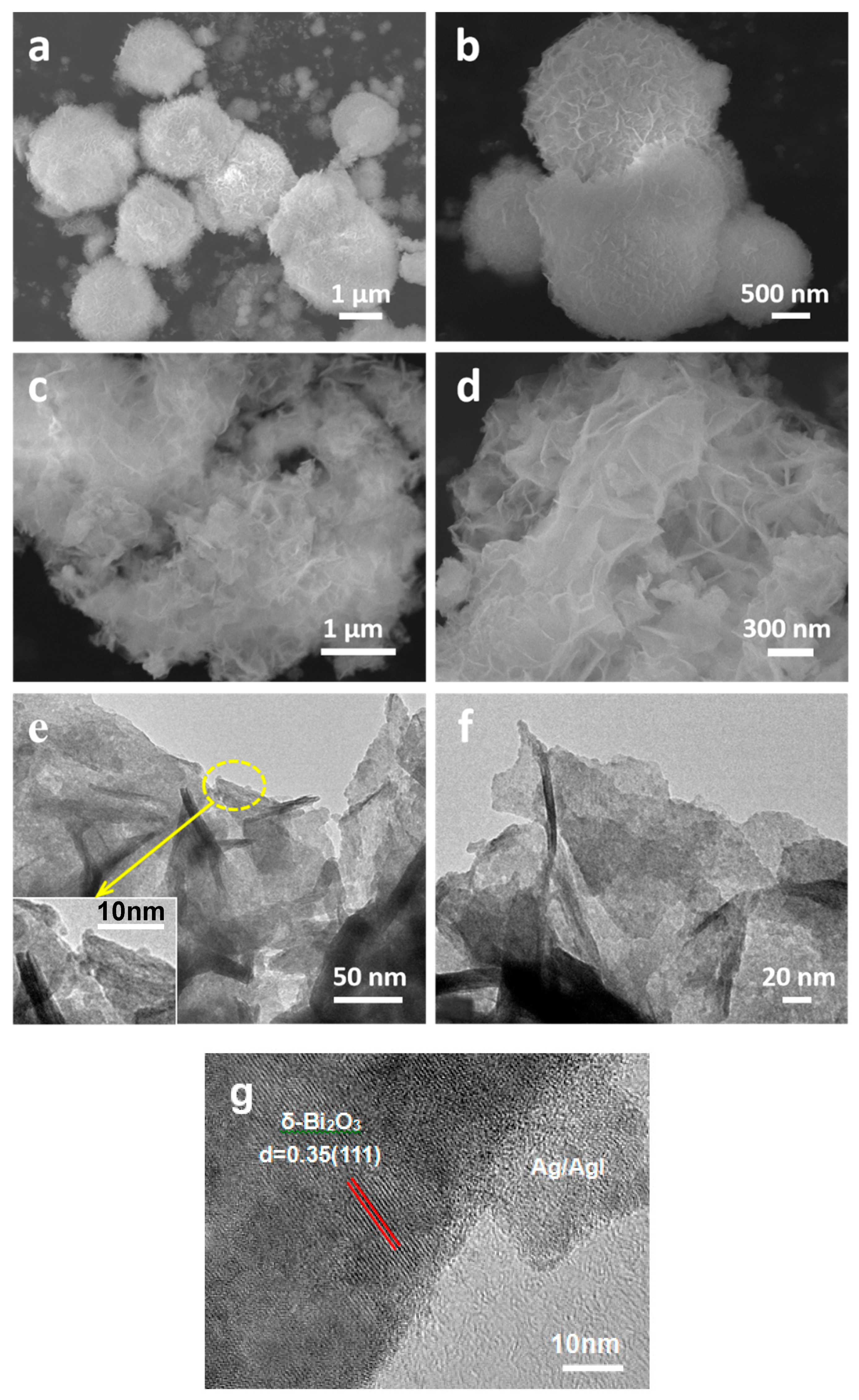



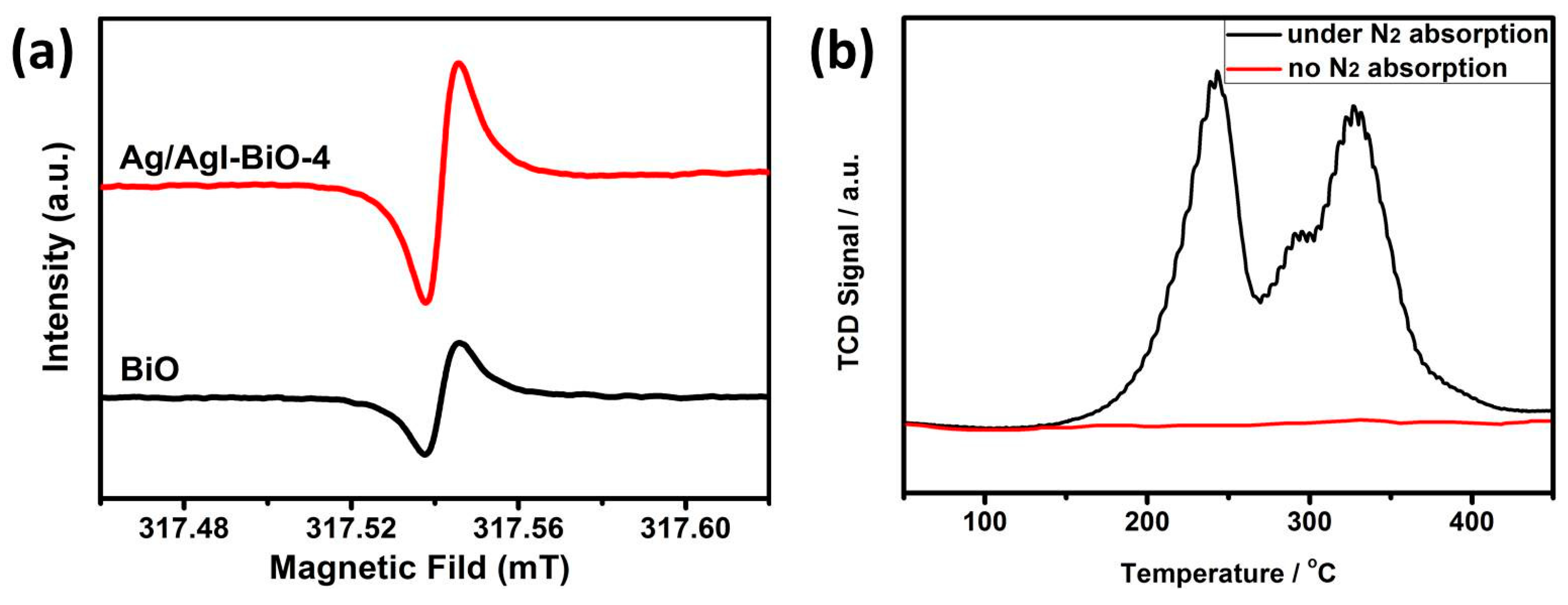

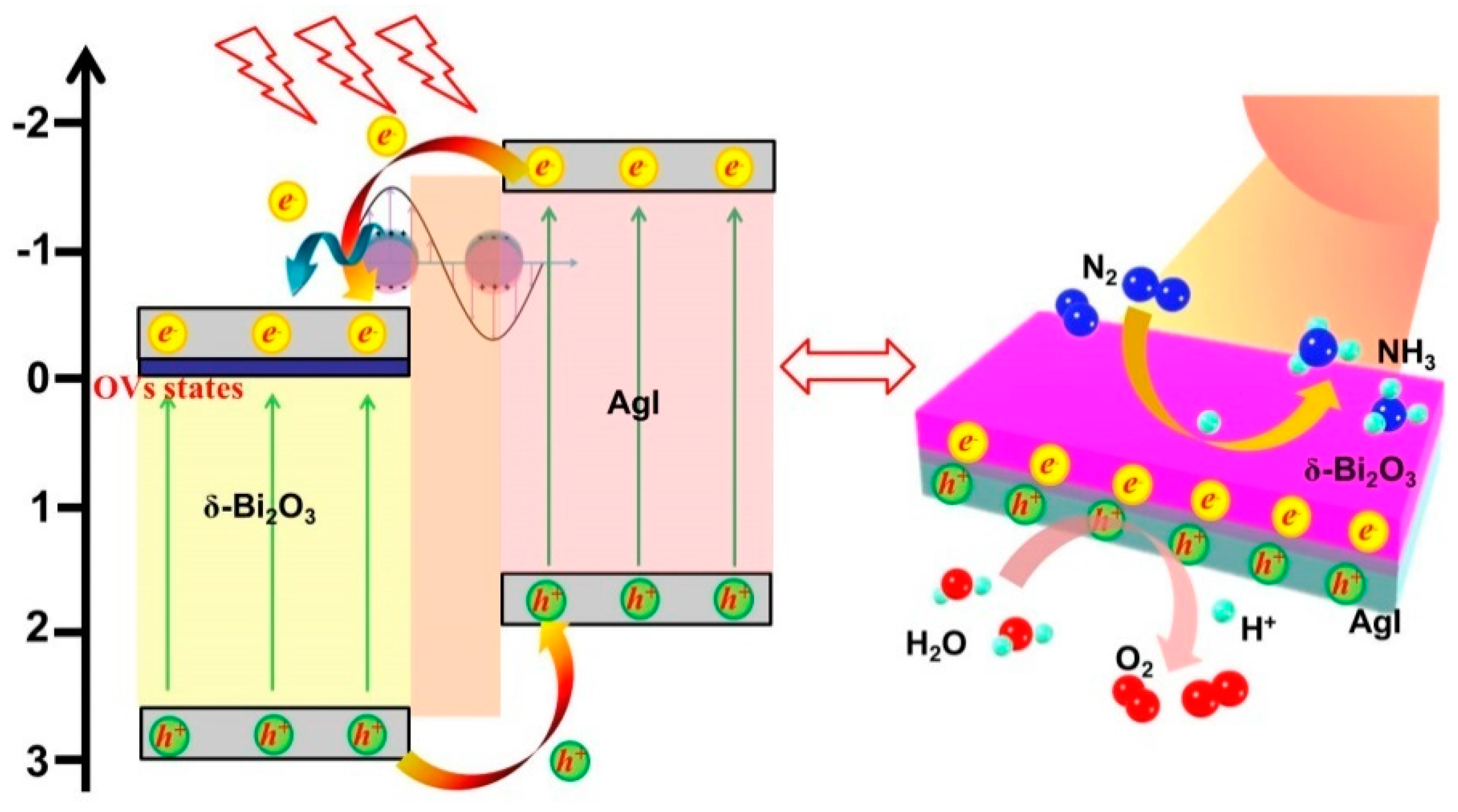
| Sample | Unit Cell Volume (Å3) | a (Å) | b (Å) | c (Å) |
|---|---|---|---|---|
| δ-Bi2O3 | 168.65 | 5.525 | 5.525 | 5.525 |
| 0.2%Ag/AgI-δ-Bi2O3 | 168.56 | 5.524 | 5.524 | 5.524 |
| 0.5%Ag/AgI-δ-Bi2O3 | 168.38 | 5.522 | 5.522 | 5.522 |
| 1%Ag/AgI-δ-Bi2O3 | 168.20 | 5.520 | 5.520 | 5.520 |
| 3%Ag/AgI-δ-Bi2O3 | 168.83 | 5.527 | 5.527 | 5.527 |
| 5%Ag/AgI-δ-Bi2O3 | 168.92 | 5.528 | 5.528 | 5.528 |
| Sample | τ1 | τ2 | χ2 | τ |
|---|---|---|---|---|
| BiO | 0.1/94.93 | 1.92/5.07 | 1.194 | 0.192 |
| Ag/AgI–BiO-1 | 0.37/96.74 | 1.39/3.24 | 1.129 | 0.403 |
| Ag/AgI–BiO-2 | 0.38/94.58 | 1.47/5.42 | 1.135 | 0.439 |
| Ag/AgI–BiO-3 | 0.42/90.25 | 1.53/9.47 | 1.112 | 0.524 |
| Ag/AgI–BiO-4 | 0.57/84.53 | 1.83/15.47 | 1.092 | 0.765 |
| Ag/AgI–BiO-5 | 0.49/88.53 | 1.56/11.47 | 1.104 | 0.613 |
© 2019 by the authors. Licensee MDPI, Basel, Switzerland. This article is an open access article distributed under the terms and conditions of the Creative Commons Attribution (CC BY) license (http://creativecommons.org/licenses/by/4.0/).
Share and Cite
Gao, X.; Shang, Y.; Gao, K.; Fu, F. Plasmon Sensitized Heterojunction 2D Ultrathin Ag/AgI-δ-Bi2O3 for Enhanced Photocatalytic Nitrogen Fixation. Nanomaterials 2019, 9, 781. https://doi.org/10.3390/nano9050781
Gao X, Shang Y, Gao K, Fu F. Plasmon Sensitized Heterojunction 2D Ultrathin Ag/AgI-δ-Bi2O3 for Enhanced Photocatalytic Nitrogen Fixation. Nanomaterials. 2019; 9(5):781. https://doi.org/10.3390/nano9050781
Chicago/Turabian StyleGao, Xiaoming, Yanyan Shang, Kailong Gao, and Feng Fu. 2019. "Plasmon Sensitized Heterojunction 2D Ultrathin Ag/AgI-δ-Bi2O3 for Enhanced Photocatalytic Nitrogen Fixation" Nanomaterials 9, no. 5: 781. https://doi.org/10.3390/nano9050781
APA StyleGao, X., Shang, Y., Gao, K., & Fu, F. (2019). Plasmon Sensitized Heterojunction 2D Ultrathin Ag/AgI-δ-Bi2O3 for Enhanced Photocatalytic Nitrogen Fixation. Nanomaterials, 9(5), 781. https://doi.org/10.3390/nano9050781




